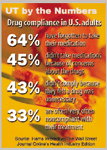Article
Men with cT3 PCa may benefit from surgery
San Antonio--Urologists who might have bypassed the option of surgery to send patients with clinical T3 (cT3) disease directly to a radiation oncologist might want to rethink the way they refer patients, according to a new study.

Mayo Clinic researchers report the typical cT3 prostate cancer patient's cancer survival is the same at 15 years for patients who undergo radical prostatectomy as it is at 5 years after radiation therapy without surgery-about 79%.
"The study makes the point that patients who are thought to have extracapsular disease and are being sent automatically to the radiation oncologist probably should be evaluated for surgery. Currently, only 15% of these patients are referred for surgery," said senior study investigator Horst Zincke, MD, PhD, a urologist and director of uro-oncologic surgery at Mayo Clinic, Rochester, MN.
Prior to PSA, in the early 1980s, clinicians under-staged about 55% of prostate cancer patients, believing that they had cT2 disease. They would send these patients to surgery and discover during prostatectomy that the cancer had, in fact, spread locally. Today, thanks in part to the PSA, 85% of patients who undergo surgery for cT2 disease have pT2 disease, according to Dr. Zincke.
PSA has also resulted in more favorable, treatable cancer being detected in early stages.
"The incidence of extracapsular prostate cancer (cT3) presenting for surgery today is only about 4%, whereas it was 25% in the 1980s," he said.
Cancer control The researchers also plotted and compared cancer-specific, overall, and disease-free survival of patients having prostatectomy for clinically advanced cT3 prostate cancer with those of patients having surgery for cT2 disease during the same period.
With more than 10 years' median follow-up, they found that freedom from local or systemic disease at 5 years after surgery for cT3 disease was 85%; it was 73% after 10 years; and 67% at 15 years. Respective cancer-specific survival rates were 95% at 5 years, 90% at 10 years, and 79% at 15 years.
They concluded that radical prostatectomy for patients with cT3 disease offers cancer control and survival rates approaching those of cT2 disease.
Interestingly, they found that 27% of the men who did not receive neoadjuvant therapy were clinically over-staged and actually had confined cancer on pathologic examination (pT2).

Complication and incontinence rates were similar after prostatectomy for cT2 and cT3 patients.
The observation that cancer survival rates at 5 years for cT3 patients post-radiation therapy are what they are at 15 years for these patients post-prostatectomy is a significant finding, according to Dr. Zincke. He and his colleagues published a 1994 study in the Journal of Clinical Oncology (1994; 12:2254-63) in which they reported that the high point of cancer deaths per year was actually not reached until year 11 post-treatment.
"So when you look at patients who have only 5-year data, it might not be too relevant because the event number is very small through the first 5 years," Dr. Zincke concluded.
The findings address a patient population in dire need of treatment, "and the treatment with radiation may not be competitive with surgery in our experience," Dr. Zincke said.
Newsletter
Stay current with the latest urology news and practice-changing insights — sign up now for the essential updates every urologist needs.















